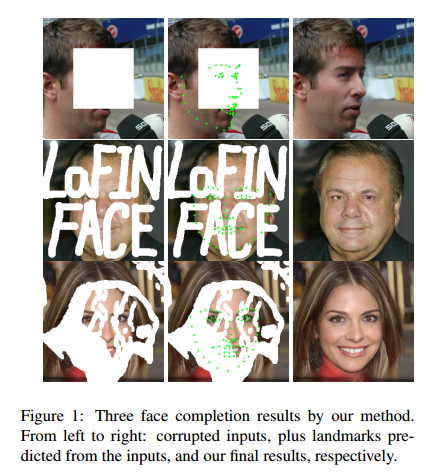This is the PyTorch implementation of paper 'LaFIn: Generative Landmark Guided Face Inpainting', which is accepted by PRCV2020 as Best Student Paper Runner-up. arXiv, PRCV
This paper studies an effective deep learning based strategy to inpaint face images in the wild, which comprises of a facial landmark predicting subnet and an image inpainting subnet. Concretely, given partial observation, the landmark predictor aims to provide the structural information (e.g. topological relationship and expression) of incomplete faces, while the inpaintor is to generate plausible appearance (e.g. gender and ethnicity) conditioned on the predicted landmarks. In addition, we validated that high-quality completed faces together with their landmarks can be utilized as augmented data to further improve the performance of (any) landmark predictor.
- Python 3.7
- Pytorch 1.0
- NVIDIA GPU + CUDA cuDNN
- Clone this repo:
git clone https://github.com/YaN9-Y/lafin
cd lafin-master
- Install Pytorch
- Install python requirements:
pip install -r requirements.txt
Our repo has two parts, 1)Image Inpainting Part and 2)Augmented Landmark Detection Part. If you only want to test Image Inpainting Part, you're safe to ignore the contents about Augmented Landmark Dectection Part.
We use CelebA and CelebA-HQ datasets for inpaint.
After downloading, you should split the whole dataset to train, test and validation set and run scripts/flist.py to genrate corresponding file lists. For example, to generate the training set file list on the CelebA dataset, you should run:
mkdir datasets
python3 ./scripts/flist.py --path path_to_celebA_train_set --output ./datasets/celeba_train_images.flist
For CelebA-HQ dataset, we use its 256x256 version. For CelebA dataset, the original image will be center cropped then resized to 256x256 during training.
For CelebA and CelebA-HQ datasets, the landmarks given by the original dataset are not enough (only 5). So we apply FAN to generate landmarks as ground truth landmarks.
You can run scripts/preprocess_landmark.py to generate landmarks of the images, then use scripts/flist.py to generate landmarks file list. For example, to generate the landmarks of the CelebA training images, you should run:
python3 ./scripts/preprocess_landmark.py --path path_to_CelebA_train_set --output path_to_the_celebA_landmark_train_set
python3 ./scripts/flist.py --path path_to_celebA_landmark_train_set --output ./datasets/celeba_train_landmarks.flist
This may take a while.
Our model is trained on a combination of random block masks and irregular masks. The irregular masks dataset provided by Liu et al. is available on their website
Then use scripts/flist.py to generate train/test/validataion masks file lists as above.
To validate the landmark detection augmented by inpainted images, please firstly download WFLW dataset provided by Wu et al..
After downloading, run scripts/preprocess_wflw.py to generate train/test/validation images and landmarks then run scripts/flist.py to generate train/test file lists.
python3 ./scripts/preprocess_wflw.py --path path_to_the_WFLW_images_folder --output path_to_the_output_folder --annotation_path path_to_the_WFLW_annotations_folder
python3 ./scripts/flist.py --path path_to_the_wflw_train/test_images/landmarks_folder --output ./datasets/wflw_train/test_images/landmarks.flist
To use the pre-trained models, download them from the following links then copy them to corresponding checkpoints folder, like ./checkkpoints/celeba or ./checkpoints/celeba-hq.
To hold a quick-testing of our inpaint model, download our pre-trained models of CelebA-HQ and put them into checkpoints/example, then run:
python3 test.py --model 3 --checkpoints ./checkpoints/example
and check the results in checkpoints/example/results.
Please notice that, as no face detector is applied at the landmark prediction stage, the landmark predictor is sensitive to the scale of face images. If you find the provided pre-trained model generalizes poorly on your own dataset, you may need to train your own model basing on your dataset.
To train the model, create a config.yml file similar to config.yml.example and copy it to corresponding checkpoint folder. Following comments on config.yml.example to set config.yml.
The inpaint model is trained in two stages: 1) train the landmark prediction model, 2) train the image inpaint model. To train the model, run:
python train.py --model [stage] --checkpoints [path to checkpoints]
For example, to train the landmark prediction model on CelebA dataset, the checkpoints folder is ./checkpoints/celeba folder, run:
python3 train.py --model 1 --checkpoints ./checkpoints/celeba
The number of training iterations can be changed by setting MAX_ITERS in config.yml.
To test the model, create a config.yml file similar to config.yml.example and copy it to corresponding checkpoint folder. Following comments on config.yml.example to set config.yml.
The model can be tested in 3 stages (landmark prediction model, inpaint model(inpaint using ground-truth landmarks) and joint model(inpainting using predicted landmarks)).
The file list of test images and landmarks can be generated using scripts/flist.py then set in the config.yml file. For testing stage 3, the test landmark file list is not needed.
For example, to test the inpaint model on CelebA dataset under ./checkpoints/celeba folder, run:
python3 test.py --model 2 --checkpoints ./checkpoints/celeba
We suppose you use WFLW dataset to validate the augmented landmark detection method. To validate the augmentation methods, a landmark-guided inpaint model trained on WFLW (stage 2) is needed. You can train it by yourself following above steps or use the pre-trained models.
Create a config.yml file similar to config.yml.example and copy it to corresponding checkpoint folder. Following comments on config.yml.example to set config.yml.
Remeber set AUGMENTATION_TRAIN = 1 to enable augmentation with inpainted images, amd LANDMARK_POINTS = 98 in config.yml.
Then run:
python3 train.py --model 1 --checkpoints ./checkpoints/wflw
to start augmentated training.
Create a config.yml file similar to config.yml.example and copy it to corresponding checkpoints folder. Following comments on config.yml.example to set config.yml.
Then run:
python3 test.py --model 1 --checkpoints ./checkpoints/wflw
to start testing the landmark detection model on WFLW. Set MASK = 0 in config.yml to achieve the highest accuracy.
If you use this code in your research, please cite our paper.
@inproceedings{yang2020generative,
title={Generative Landmark Guided Face Inpainting},
author={Yang, Yang and Guo, Xiaojie},
booktitle={Chinese Conference on Pattern Recognition and Computer Vision (PRCV)},
pages={14--26},
year={2020},
organization={Springer}
}
@article{yang2019lafin,
title={Lafin: Generative landmark guided face inpainting},
author={Yang, Yang and Guo, Xiaojie and Ma, Jiayi and Ma, Lin and Ling, Haibin},
journal={arXiv preprint arXiv:1911.11394},
year={2019}
}
